 W
WAn optical spectrometer is an instrument used to measure properties of light over a specific portion of the electromagnetic spectrum, typically used in spectroscopic analysis to identify materials. The variable measured is most often the light's intensity but could also, for instance, be the polarization state. The independent variable is usually the wavelength of the light or a unit directly proportional to the photon energy, such as reciprocal centimeters or electron volts, which has a reciprocal relationship to wavelength.
 W
WA spectrometer is a scientific instrument used to separate and measure spectral components of a physical phenomenon. Spectrometer is a broad term often used to describe instruments that measure a continuous variable of a phenomenon where the spectral components are somehow mixed. In visible light a spectrometer can separate white light and measure individual narrow bands of color, called a spectrum. A mass spectrometer measures the spectrum of the masses of the atoms or molecules present in a gas. The first spectrometers were used to split light into an array of separate colors. Spectrometers were developed in early studies of physics, astronomy, and chemistry. The capability of spectroscopy to determine chemical composition drove its advancement and continues to be one of its primary uses. Spectrometers are used in astronomy to analyze the chemical composition of stars and planets, and spectrometers gather data on the origin of the universe.
 W
WAlice is an ultraviolet imaging spectrometer for spacecraft, with one used on the New Horizons spacecraft, and another on the Rosetta spacecraft. Alice is a small telescope with a spectrograph and a special detector with 32 pixels each with 1024 spectral channels detecting ultraviolet light.
 W
WThe Cary Model 14 UV-VIS Spectrophotometer was a double beam recording spectrophotometer designed to operate over the wide spectral range of ultraviolet, visible and near infrared wavelengths (UV/Vis/NIR). This included wavelengths ranging from 185 nanometers to 870 nanometers.
 W
WThe Compact Reconnaissance Imaging Spectrometer for Mars (CRISM) is a visible-infrared spectrometer aboard the Mars Reconnaissance Orbiter searching for mineralogic indications of past and present water on Mars. The CRISM instrument team comprises scientists from over ten universities and led by principal investigator Scott Murchie. CRISM was designed, built, and tested by the Johns Hopkins University Applied Physics Laboratory.
 W
WThe computed tomography imaging spectrometer (CTIS) is a snapshot imaging spectrometer conceived separately by Takayuki Okamoto and Ichirou Yamaguchi at Riken (Japan), and by F. Bulygin and G. Vishnakov in Moscow (Russia). The concept was subsequently further developed by Michael Descour, at the time a PhD student at the University of Arizona, under the direction of Prof. Eustace Dereniak.
 W
WThe Dobson spectrophotometer, also known as Dobsonmeter, Dobson spectrometer, or just Dobson is one of the earliest instruments used to measure atmospheric ozone.
 W
WThe DU spectrophotometer or Beckman DU, introduced in 1941, was the first commercially viable scientific instrument for measuring the amount of ultraviolet light absorbed by a substance. This model of spectrophotometer enabled scientists to easily examine and identify a given substance based on its absorption spectrum, the pattern of light absorbed at different wavelengths. Arnold O. Beckman's National Technical Laboratories developed three in-house prototype models and one limited distribution model (D) before moving to full commercial production with the DU. Approximately 30,000 DU spectrophotometers were manufactured and sold between 1941 and 1976.
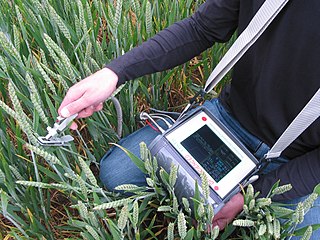 W
WA fluorometer or fluorimeter is a device used to measure parameters of visible spectrum fluorescence: its intensity and wavelength distribution of emission spectrum after excitation by a certain spectrum of light. These parameters are used to identify the presence and the amount of specific molecules in a medium. Modern fluorometers are capable of detecting fluorescent molecule concentrations as low as 1 part per trillion.
 W
WA gamma-ray spectrometer (GRS) is an instrument for measuring the distribution of the intensity of gamma radiation versus the energy of each photon. The study and analysis of gamma-ray spectra for scientific and technical use is called gamma spectroscopy, and gamma-ray spectrometers are the instruments which observe and collect such data. Because the energy of each photon of EM radiation is proportional to its frequency, gamma rays have sufficient energy that they are typically observed by counting individual photons.
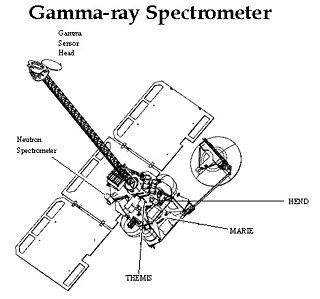 W
WThe Gamma Ray Spectrometer (GRS) is a gamma-ray spectrometer on the 2001 Mars Odyssey spacecraft, a space probe orbiting the planet Mars since 2001. Part of NASA's Mars Surveyor 2001 program, it returns geological data about Mars's surface such as identifying elements and the location of water. It is maintained by the Lunar and Planetary Laboratory at the University of Arizona in the United States. This instrument has mapped the distribution surface hydrogen, thought to trace water in the surface layer of Martian soil.
 W
WThe Gamma-Ray Imaging Spectrometer (GRIS) was a gamma-ray spectrometer instrument on a balloon-borne airborne observatory. It used germanium detectors to achieve high resolution spectroscopy. GRIS was operated from 1988 to 1995 by NASA's Goddard Space Flight Center, which called it "arguably one of the most successful gamma-ray balloon programs in history".
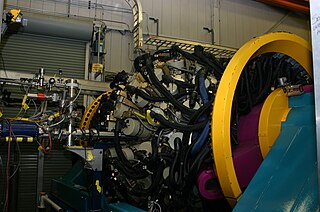 W
WThe Gammasphere is a third generation gamma ray spectrometer used to study rare and exotic nuclear physics. It consists of 108 Compton-suppressed large volume, high-purity germanium detectors arranged in a spherical shell.
 W
WGlobal-scale Observations of the Limb and Disk (GOLD) is a heliophysics Mission of Opportunity (MOU) for NASA's Explorers program. Led by Richard Eastes at the Laboratory for Atmospheric and Space Physics, which is located at the University of Colorado Boulder, GOLD's mission is to image the boundary between Earth and space in order to answer questions about the effects of solar and atmospheric variability of Earth's space weather. GOLD was one of 11 proposals selected, of the 42 submitted, for further study in September 2011. On 12 April 2013, NASA announced that GOLD, along with the Ionospheric Connection Explorer (ICON), had been selected for flight in 2017. GOLD, along with its commercial host satellite SES-14, launched on 25 January 2018.
 W
WGlueX is a particle physics experiment located at the Thomas Jefferson National Accelerator Facility (JLab) accelerator. Its primary purpose is to better understand the nature of confinement in quantum chromodynamics (QCD) by identifying a spectrum of hybrid and exotic mesons generated by the excitation of the gluonic field binding the quarks. Such mesonic states are predicted to exist outside of the well-established quark model, but none have been definitively identified by previous experiments. A broad high-statistics survey of known light mesons up to and including the is also underway.
 W
WAn imaging spectrometer is an instrument used in hyperspectral imaging and imaging spectroscopy to acquire a spectrally-resolved image of an object or scene, often referred to as a datacube due to the three-dimensional representation of the data. Two axes of the image corresponds to vertical and horizontal distance and the third to wavelength. The principle of operation is the same as that of the simple spectrometer, but special care is taken to avoid optical aberrations for better image quality.
 W
WThe K-band multi-object spectrograph, or KMOS for short, is an instrument mounted on ESO’s Very Large Telescope Antu (UT1) at the Paranal Observatory in Chile. KMOS is able to observe 24 objects at the same time in infrared light and to map out how their properties vary from place to place. It will provide crucial data to help understand how galaxies grew and evolved in the early Universe.
 W
WMars Reconnaissance Orbiter (MRO) is a spacecraft designed to study the geology and climate of Mars, provide reconnaissance of future landing sites, and relay data from surface missions back to Earth. It was launched on August 12, 2005 and reached Mars on March 10, 2006. In November 2006, after five months of aerobraking, it entered its final science orbit and began its primary science phase. The cost to develop and operate MRO through the end of its prime mission in 2010 was US$716.6 million.
 W
WThe Miniature Thermal Emission Spectrometer (Mini-TES) is an infrared spectrometer used for detecting the composition of a material from a distance. By making its measurements in the thermal infrared part of the electromagnetic spectrum, it has the ability to penetrate through the dust coatings common to the Martian surface which is usually problematic for remote sensing observations. There is one on each of the two Mars Exploration Rovers.
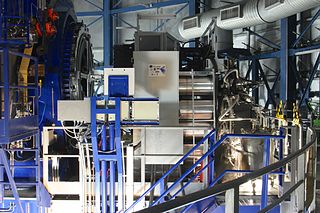 W
WThe multi-unit spectroscopic explorer (MUSE) is an integral field spectrograph installed at the Very Large Telescope (VLT) of the European Southern Observatory (ESO). It operates in the visible wavelength range, and combines a wide field of view with a fine spatial sampling and a large simultaneous spectral range. It is designed to take advantage of the improved spatial resolution provided by adaptive optics. MUSE had first light on the VLT on 31 January 2014.
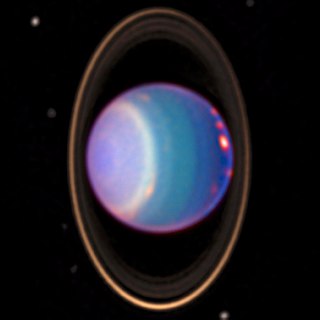 W
WThe Near Infrared Camera and Multi-Object Spectrometer (NICMOS) is a scientific instrument for infrared astronomy, installed on the Hubble Space Telescope (HST), operating from 1997 to 1999, and from 2002 to 2008. Images produced by NICMOS contain data from the near-infrared part of the light spectrum.
 W
WA nondispersive infrared sensor is a simple spectroscopic sensor often used as a gas detector. It is non-dispersive in the fact that no dispersive element is used to separate out the broadband light into a narrow spectrum suitable for gas sensing. The majority of NDIR sensors use a broadband lamp source and an optical filter to select a narrow band spectral region that overlaps with the absorption region of the gas of interest. In this context narrow may be 50-300nm bandwidth. Modern NDIR sensors may use Microelectromechanical systems (MEMs) or mid IR LED sources, with or without an optical filter.
 W
WThe Orbiting Carbon Observatory-3 (OCO-3) is a NASA-JPL instrument designed to measure carbon dioxide in Earth's atmosphere. The instrument is mounted on the Japanese Experiment Module-Exposed Facility on board the International Space Station (ISS). OCO-3 was scheduled to be transported to space by a SpaceX Dragon from a Falcon 9 rocket on 30 April 2019, but the launch was delayed to 3 May, due to problems with the space station's electrical power system. This launch was further delayed to 4 May due to electrical issues aboard Of Course I Still Love You (OCISLY), the barge used to recover the Falcon 9’s first stage. OCO-3 was launched as part of CRS-17 on 4 May 2019 at 06:48 UTC. The nominal mission lifetime is three years.
 W
WThe ozone monitoring instrument (OMI) is a nadir-viewing visual and ultraviolet spectrometer aboard the NASA Aura spacecraft. Aura flies in formation about 15 minutes behind Aqua, both of which orbit the earth in a polar Sun-synchronous pattern. Aura was launched on July 15, 2004, and OMI has collected data since August 9, 2004. OMI can distinguish between aerosol types, such as smoke, dust, and sulfates, and can measure cloud pressure and coverage, which provide data to derive tropospheric ozone. OMI follows in the heritage of TOMS, SBUV, GOME, SCIAMACHY, and GOMOS. OMI measurements cover a spectral region of 264–504 nm (nanometers) with a spectral resolution between 0.42 nm and 0.63 nm and a nominal ground footprint of 13 × 24 km2 at nadir. The Aura satellite orbits at an altitude of 705 km in a sun-synchronous polar orbit with an exact 16-day repeat cycle and wit h a local equator crossing time of 13. 45 on the ascending node. The orbital inclination is 98.1 degrees, providing latitudinal coverage from 82° N to 82° S. It is a wide-field-imaging spectrometer with a 114° across-track viewing angle range that provides a 2600 km wide swath, enabling measurements with a daily global coverage. OMI is continuing the TOMS record for total ozone and other atmospheric parameters related to ozone chemistry and climate.
 W
WThe Planetary Fourier Spectrometer (PFS) is an infrared spectrometer built by the Istituto Nazionale di Astrofisica along with the Istituto di Fisica dello spazio Interplanetario and the Consiglio Nazionale delle Ricerche. The instrument is currently used by the European Space Agency on both the Mars Express Mission and the Venus Express Mission. It consists of four units which together weigh around 31.4 kg, including a pointing device, a power supply, a control unit, and an interferometer with electronics.
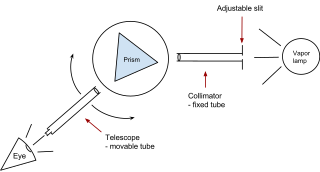 W
WA prism spectrometer is an optical spectrometer which uses a dispersive prism as its dispersive element. The prism refracts light into its different colors (wavelengths). The dispersion occurs because the angle of refraction is dependent on the refractive index of the prism's material, which in turn is slightly dependent on the wavelength of light that is traveling through it.
 W
WA push broom scanner, also known as an along-track scanner, is a device for obtaining images with spectroscopic sensors. The scanners are regularly used for passive remote sensing from space, and in spectral analysis on production lines, for example with near-infrared spectroscopy used to identify contaminated food and feed. The moving scanner line in a traditional photocopier is also a familiar, everyday example of a push broom scanner. Push broom scanners and the whisk broom scanners variant are often contrasted with staring arrays, which image objects without scanning, and are more familiar to most people.
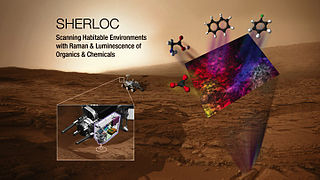 W
WScanning Habitable Environments with Raman and Luminescence for Organics and Chemicals (SHERLOC) is an ultraviolet Raman spectrometer that uses fine-scale imaging and an ultraviolet (UV) laser to determine fine-scale mineralogy, and detect organic compounds designed for the Perseverance rover as part of the Mars 2020 mission. It was constructed at the Jet Propulsion Laboratory with major subsystems being delivered from Malin Space Science Systems and Los Alamos National Laboratory. The Principal Investigator is Luther Beegle, and the Deputy Principal Investigator is Rohit Bhartia.
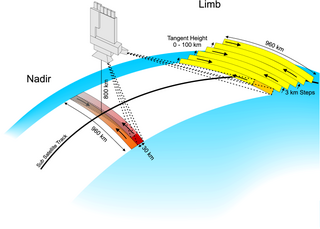 W
WSCIAMACHY was one of ten instruments aboard of ESA's ENVIronmental SATellite, ENVISAT. It was a satellite spectrometer designed to measure sunlight, transmitted, reflected and scattered by the earth's atmosphere or surface in the ultraviolet, visible and near infrared wavelength region at moderate spectral resolution. SCIAMACHY was built by Netherlands and Germany at TNO/TPD, SRON and Dutch Space.
 W
WA scintillation counter is an instrument for detecting and measuring ionizing radiation by using the excitation effect of incident radiation on a scintillating material, and detecting the resultant light pulses.
 W
WThe Special Sensor Ultraviolet Limb Imager (SSULI) is an imaging spectrometer that is used to observe the earth's ionosphere and thermosphere. These sensors provide vertical intensity profiles of airglow emissions in the extreme ultraviolet and far ultraviolet spectral range of 800 to 1700 Angstrom and scan from 75 km to 750 km tangent altitude. The data from these sensors will be used to infer altitude profiles of ion, electron and neutral density.
 W
WThe Spectronic 20 is a brand of single-beam spectrophotometer, designed to operate in the visible spectrum across a wavelength range of 340 nm to 950 nm, with a spectral bandpass of 20 nm. It is designed for quantitative absorption measurement at single wavelengths. Because it measures the transmittance or absorption of visible light through a solution, it is sometimes referred to as a colorimeter. The name of the instrument is a trademark of the manufacturer.
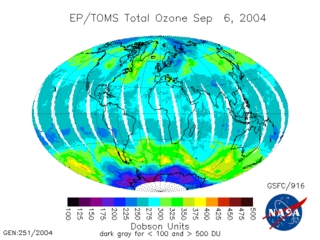 W
WThe Total Ozone Mapping Spectrometer (TOMS) was a NASA satellite instrument, specifically a spectrometer, for measuring the ozone layer. Of the five TOMS instruments which were built, four entered successful orbit. The satellites carrying TOMS instruments were:Nimbus 7; launched October 24, 1978. Operated until 1 August 1994. Carried TOMS instrument number 1. Meteor-3-5; launched 15 August 1991. Operated until December 1994. Was the first and last Soviet satellite to carry a USA made instrument. Carried TOMS instrument number 2. ADEOS I; launched 17 August 1996. Operated until 30 June 1997. Mission was cut short by a spacecraft failure. TOMS-Earth Probe; launched on July 2, 1996. Operated until 2 December 2006. Carried TOMS instrument number 3. QuikTOMS; launched 21 September 2001. Suffered launch failure and did not enter orbit.
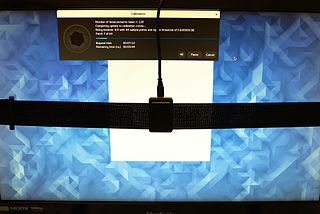 W
WA Tristimulus colorimeter, colloquially shortened to colorimeter, is used in digital imaging, to profile and calibrate output devices. It takes a limited number of wideband spectral energy readings along the visible spectrum by using filtered photodetectors; e.g. silicon photodiodes.
 W
WTropospheric Emissions: Monitoring of Pollution (TEMPO) is a NASA Earth Venture-Instrument that will measure North American pollution at a high resolution and on an hourly basis. It is an ultraviolet–visible spectrometer maintaining a constant view of North America, enabling it to provide daily data on ozone, nitrogen dioxide, and other elements in the atmosphere.
 W
WThe Venus Emissivity Mapper (VEM) is a spectrometer mapping the surface composition of Venus through a distinct number of atmospheric spectral windows. It will be one of the two payloads onboard the VERITAS mission, and represents the VenSpec-M channel of the EnVision mission's spectrometer suite.